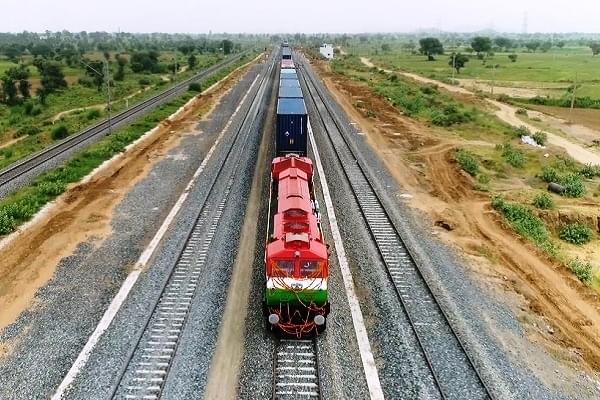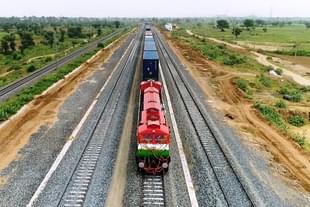Infrastructure
Indian Railways’ Dedicated Freight Corridor Will Change More Than Just The Way Goods Are Hauled
Tushar Gupta
Feb 06, 2020, 09:49 AM | Updated 09:49 AM IST
Save & read from anywhere!
Bookmark stories for easy access on any device or the Swarajya app.


To understand the scale and significance the Dedicated Freight Corridors (DFCs) will achieve in the next 30-40 years, some imagination is warranted.
In isolation, the Eastern Dedicated Freight Corridor (EDFC) or the Western Dedicated Freight Corridor (WDFC) may be viewed as projects with tremendous economic potential and with an opportunity to drive socio-economic transformation, but it will be the cumulative working of all the DFCs that will signify the biggest leap for Indian Railways (IR) since 1947 while transforming logistics in India completely by 2047, India’s 100th year of independence.
To further one’s imagination, a parallel can be drawn between the Delhi Metro and the DFCs on the front of socio-economic transformation.
In late 2002, when the Delhi Metro first began commercial operations, there were 6 stations and one line. The total track length was a mere 8.3 kilometres.
Thus, for most residents of the National Capital Region, the metro was merely an engineering marvel and not an enabler of a socio-economic transformation.
Today, 17-years later, the Delhi Metro operates 12 lines across the NCR region, has close to 260 stations, daily ridership of more than 5 million, and a network length exceeding 340 kilometres.
Simply put, life without the metro is unthinkable for NCR residents, 25-years after it was announced and 17-years after it was launched.
The fate of DFC would be the same, however, at a scale so big that it was previously unimaginable and as of now, unquantifiable, for the numbers are mind-boggling.
The Numbers
The long-term goal of the Ministry of Railways is to have high capacity and high-speed corridors along the Golden Quadrilateral.
While 4 corridors will run along the perimeter of the Golden Quadrilateral, two more will be constructed as the diagonals of this network, taking the total number to 6.
For phase-1, two corridors have been selected. Firstly, the Eastern Dedicated Freight Corridor (EDFC).
The EDFC will have a route length of 1,800 kilometres, approximately, and will connect Ludhiana in Punjab to Dankuni in West Bengal.
The EDFC will go through the states Punjab, Haryana, Uttar Pradesh, Bihar, Jharkhand, and West Bengal.
The second corridor is the Western Dedicated Freight Corridor (WDFC). The WDFC, with a route length of about 1,500 kilometres would connect Dadri in Uttar Pradesh to the Jawaharlal Nehru Port Trust (JNPT) in Mumbai.
The WDFC will pass through the states of Uttar Pradesh, Haryana, Rajasthan, Gujarat, and Maharashtra.
Apart from the two corridors, four more corridors will be constructed in the future. Firstly, the East-West Corridor that shall pass through the states of Maharashtra, Madhya Pradesh, Chhattisgarh, Odisha, and West Bengal. The length of this corridor will be 2,000 kilometres.
A North-South corridor, with a route length of 2173 kilometres will also be constructed.
This shall pass through Delhi, Uttar Pradesh, Madhya Pradesh, Maharashtra, Telangana, Andhra Pradesh, and will terminate in Chennai, Tamil Nadu.
An East-East corridor, running along the eastern seaboard with a route length of 1100 kilometres has also been announced.
This will start in West Bengal, pass through Odisha, Andhra Pradesh, and terminate in Chennai.
Lastly, a South-South Corridor, starting from Chennai, will pass through Andhra Pradesh and Karnataka, and will terminate in Goa.
An extension branching from Bengaluru to Mangalore has also been proposed.
The combined route length of the six DFCs is almost 9500 kilometres. To put things in perspective, the total Indian Railway route length was 53,596 kilometres in 1950, increasing to 67,368 kilometres in 2018, that is an increase of around 13,772 kilometres in 68-years.
With DFCs, the government aims to put 10,000 kilometres of new route length into operations within the next 10-years.
It must also be noted that China built 9,000 kilometres worth of new railway in 2015 alone.
In 2013-14, IR enabled more than 8.4 billion trips and 1.05 billion tons of freight. In 1947, when an independent India inherited an elaborate rail network from the British Raj, 90 per cent of inland movement of goods was facilitated by the IR.
However, investments in IR slowed down in the following decades. Thus, the relative share of rail in total freight traffic declined from 86.2 per cent in 1960-61 to 63.5 per cent in 1980-81 while for the same period, the share of road traffic went from 13.8 per cent to 36.5 per cent.
Post the 1991-reforms, as the movement of freight traffic across the country intensified, the rail share fell from 62.6 per cent at the beginning of the 1990s to merely 39.0 per cent by the end of it.
The road share, meanwhile, increased from 37.4 per cent to 61 per cent. By 2007-08, rail and road share in freight traffic movement stood at 33 per cent and 67 per cent respectively.
While the increasing share of roads in facilitating freight movement did have its own benefits, like the construction of highways, the hustling hospitality industry in some parts of India, and even real estate to some extent, factors like increasing traffic and pollution are now shackling the Indian roads when it comes to freight movement. The problem isn't lack of goods, but lack of space on the roads to move them effectively.
The IR, because of its inability to add any more freight capacity to its existing network, has been consistently losing out to road haulage.
Two-third of train-kms is currently for passenger use and given the inevitable delays with cascading effects on other routes and trains, the IR was in an urgent need of an overhaul, the same which the DFC network will enable.
The upgraded design features for the trains running on the DFCs will also add to the capacity.
Against the existing height of 4.265m for conventional freight traffic, the EDFC will allow 5.1m for the EDFC and 7.1m for the WDFC.
Against the existing width of 3,200mm, trains on DFCs would have run on a railway line of 3,600mm width.
While existing freight trains have the capacity for a single stack, trains on the DFCs will have the capacity for a double stack.
The train length would increase from 700m on normal existing lines to 1,500m on the DFCs.
The trainload would increase from 4,000 tons on existing lines to 15000 tons on the DFCs.
While trains run at an average speed of 75km/h on existing lines, trains on DFCs will run at a speed of 100km/h.
Even the station spacing is set to extend from 7-10 kilometres to 40 kilometres.
DFCs: Making Indian Railways Great Again
DFCs are essential for many reasons.
Firstly, they will enable the decongestion of roads in the long run. While investments in electric vehicles (EVs) are still in their nascent stages, it will be a while before conventional heavy diesel trucks are replaced by EVs.
However, assuming we have the technology to replace all these trucks with EVs by 2035 (a very optimistic assumption), the problem of congestion on the roads shall remain.
Secondly, for 2007-08, the share of roads in freight transportation, in Net Tonne Kilometre (NTKM), in billions, stood at 50.1 per cent.
1 NTKM stands for transportation of 1 tonne of goods over 1 km.
While the argument for more highways may help the government accommodate more NTKMs, the growing e-commerce sector which is estimated to cross $100 billion by 2022, and would constitute 8 per cent of retail sales by 2030, would require alternate economically viable routes to move freight.
Three, our goal of being a $5 trillion economy by 2025 or even a $10 trillion by 2030 warrants urgent addressing of logistics.
While government programmes like Mudra loans for MSMEs, ‘Make in India’, and the JAM trinity can enable socio-economic inclusion, the efficient transfer of goods is what is going to make all the difference in the long run.
In the case of the EDFC, the direct beneficiaries would be the power and heavy manufacturing industries of Northern and Eastern India, given their reliance on railways for material transportation, distribution of bulk processed and semi-processed commodities along with consumer products to busy ports.
With the introduction of the EDFC and the WDFC, the biggest beneficiaries are going to be the industries which depend or work with commodities like coal, food grains, iron ore, iron and steel, cement, and fertilisers.
Along these two corridors, the warehousing sector will also receive a boost, especially near the stations.
Four, critical economies across the world have their own DFCs. China’s new DFCs have been designed with the objective to link hinterland areas with ports, along with the aim to transfer commodities, raw materials, and other critical resources of production to-and-fro from the northern to the southern region.
As per their recent plans, China aims to divorce its passenger traffic completely from its freight traffic by 2020.
In Europe, Germany has a DFC, however, integrated with the passenger network. Similarly, Netherland is factoring issues of economic viability along their DFCs.
Freight Railways in America, though privately-owned, is one of the best in the world, and while some of its routes are used by passenger Amtrak service trains, it carries 4 times the freight for a single kilometre.
While China carried 3,358 million tonnes of freight in 2015 via rail, for India the number stood at 1,220 million tonnes as late as 2018.
Clearly, for its geographic scale, India must look at China and the US as ideal examples when it comes to DFCs.
The other lesson India must learn from China is of timely operationalisation of DFCs. As late as 2016, 77 per cent of China’s freight movement relied on highways, thus contributing heavily to pollution, while only 8 per cent moved on the rail.
In fact, China’s construction boom resulted in a declining share of rail in freight traffic from 2011 to 2015.
Therefore, to save India’s highways and cities from the pollution caused by diesel trucks, it’s imperative that the DFC infrastructure matches the pace of the growing economy. Let’s leave the highways for consumer electric vehicles, please.
Lastly, there is the question of the long-term future of Indian Railways as well. Already, the IR is planning to privatise certain busy passenger routes, and therefore, for these routes to operate without any delays and for the IR to start planning for a high-speed railway network by the end of the 2020s, there is an urgent need to separate freight traffic from passenger traffic.
The DFCs project is the biggest leap for Indian Railways, not just because of its route length, but also because of the technology it ushers, the rail infrastructure it will enable, and the socio-economic transformation it shall result in.
20-30 years from now, the DFCs are going to be indispensable to India’s logistics sector. From private to public, every company would want a ride on these corridors.
Also, it would be interesting to see the potential all these corridors hold for the regions they pass through.
This is the decade of the DFCs, and if done right, would be a great achievement for any government in independent India, an achievement the Modi government would want as a part of their legacy.
Tushar is a senior-sub-editor at Swarajya. He tweets at @Tushar15_





